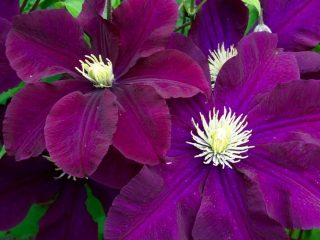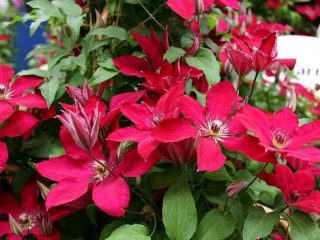Content
Climbing plants are used for vertical gardening, which is why the elegant clematis Honora enjoys well-deserved popularity among landscape designers. If you properly care for this elegant vine, then there will be no problems when growing it. Representatives of the variety easily adapt to cultivation conditions, but you should not forget about small vagaries.
Description of clematis Honora
The beautiful clematis Honora is a large-flowered species native to New Zealand. It is a hybrid of Gipsy Queen, so it received the best characteristics of its relative. A shrub climbing plant reaches a height of three meters. The branches of the vine have large dark green leaves.
It is easy to recognize clematis varieties Honora by their flowers. With proper care, the huge buds reach 15 cm in diameter. The petals with wavy decorative edges are painted in a rich purple hue, turning into violet. Around the miniature pistil are short, fluffy stamens.
Clematis Honora pruning group
In order to maintain the beauty of a climbing plant at home, you need to properly organize the shortening of the shoots. Representatives of a culture are divided into three types of branching, each of which requires an individual approach.Pruning branches stimulates the formation of vines and has a positive effect on the development of roots.
The clematis variety Honor, like the mother plant Gipsy Queen, actively branches, therefore it is classified in group 3. The culture forms inflorescences only on young shoots of the current year. The lashes are cut almost to ground level, bushes with 4 internodes, 20 to 50 cm long, are left above the surface. The procedure is carried out in the fall, from October to November.
Planting and caring for clematis Honor
Liana prefers to grow in fertile sandy, loamy soil with a low acid and alkaline reaction. Clematis Honora grows well in both bright sun and light partial shade. Areas with close groundwater, not protected from drafts and near the house are contraindicated. The recommended distance from buildings and trees is 30 cm.
Clematis Honora seedlings are planted in autumn and spring. A hole is dug in advance according to the pattern 60*60*60 cm, sprinkled on top with a thick layer of drainage (at least 15 cm) made of expanded clay or broken brick. Add a mixture of:
- compost;
- sand;
- peat
Supports for lashes, up to 2.5 m high, are dug into the sides of the hole. A hill of loose soil is formed above the nutrient “cushion”. The bush is planted so that the neck is 5 cm above the soil level. Carefully straighten the lower parts along the ground, bury and mulch. After the procedure, water generously.
To ensure that clematis Honor flowers do not differ from the photo, it is necessary to organize competent care. Cultivation involves irrigation at the appropriate time and regular application of fertilizers.In the first year, the plant lives on reserves from the “cushion”, but from the next season it is fed in spring and summer every 2 weeks. Alternate complex mineral preparations and humus.
Lack of moisture negatively affects the appearance of the vine. In hot weather, the buds of clematis Honora become smaller and the flowering period is shortened. In the heat, water generously with settled warm water, trying to get it on the foliage. The procedure is carried out after sunset, 3 times a week. For young specimens, 20 liters are enough, and for mature ones – at least 40. They ensure the removal of excess moisture from the hole, regularly loosen the soil, mulch with peat and sawdust.
Climbing plants must be fixed on supports. In landscape design, trellises in the form of arches, fans and pyramids are used. The thickness of the slats should not be more than 1.2 cm in diameter, otherwise it will be difficult for the bush to branch. The more green the Honora clematis is, the heavier the crop is after the rain. When choosing a material for construction, preference is given to strong metal mesh on pipes.
Preparing for winter
The undemanding vine can withstand low temperatures, but does not like cold without snow. When purchasing clematis Honor for the Moscow region, you must take care of reliable shelter. In autumn, the plant is watered and fertilized abundantly. Before frost, the lashes are cut off and the root collar is treated with Bordeaux mixture.
A bucket of humus is poured around the Honora clematis bush and hilled to a height of 15 cm with a mixture of sand and ash. In November, mulch the ground with sawdust and pine needles. The plant is not afraid of low temperatures, but of spring damping off. Protective structures are removed after stable warm weather sets in.
Reproduction
Large-flowered species do not retain their characteristics when sown. In the description with photo of the clematis variety Honora, it is indicated that the hybrid is bred vegetatively. Young specimens up to 6 years old can be propagated by root division. The overgrown vine is carefully dug up, cleared of soil and cut with pruning shears. Sprouts with buds on the root collar will take root.
In summer, a young plant is obtained by tapping. A faded whip with a noticeable upper eye is fixed in pots with soil. Clematis is sprayed and watered with Kornevin solution. As it develops, add fresh soil. By autumn, strong seedlings of clematis Honora grow from the branches.
During autumn pruning, cuttings can be taken from strong branches. Remove the foliage and separate the woody part down to the first living bud. They are placed in a ditch with peat, covered with earth, and covered for the winter with a thick layer of foliage and spruce branches. In spring, the area is watered abundantly, mulched with humus and sawdust. In the fall, clematis cuttings are ready to be transplanted to their proper place of growth.
Diseases and pests
Clematis Honora is a tenacious vine that has strong immunity. If you regularly violate the rules of agricultural technology, the crop weakens. Plants suffer from fungal diseases:
- fusarium wilt;
- powdery mildew;
- gray rot.
Diseases affect the roots and then destroy the above-ground parts. You can notice manifestations in early spring. To prevent clematis Honor from dying, it is necessary to treat the affected vines with fungicides (Fundazol, Azocene). Fungal rust appears as brown spots on leaves and shoots. Diseased specimens dry out and the branches become deformed. A product based on copper chloride and 1% Bordeaux mixture will help destroy the disease.
In dry weather, clematis Honora is affected by spider mites and scale insects, which feed on the intercellular sap of the foliage. Migrating aphids parasitize greenery and shoots. In spring, slugs and vine snails are dangerous, and in winter, mice gnaw out the roots.
Conclusion
Bright clematis Honora is an original hybrid that will help decorate the area next to the house. The plant is not capricious when grown, so care is understandable even for novice gardeners. The liana is easy to propagate vegetatively at home.










